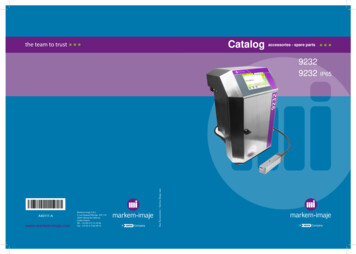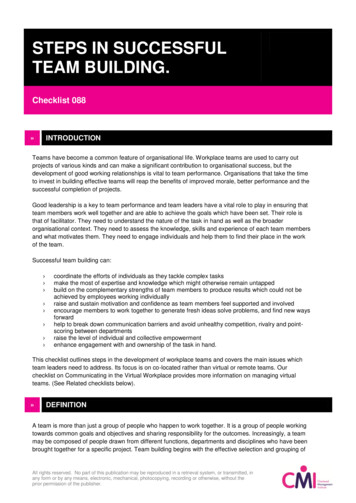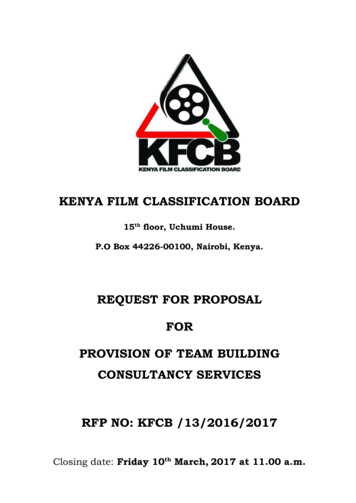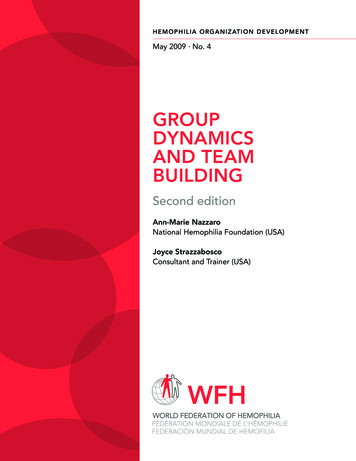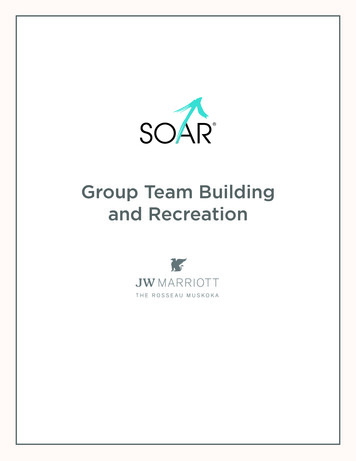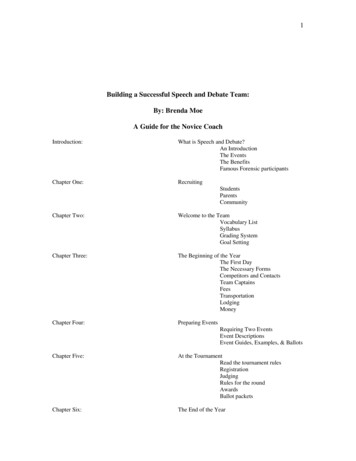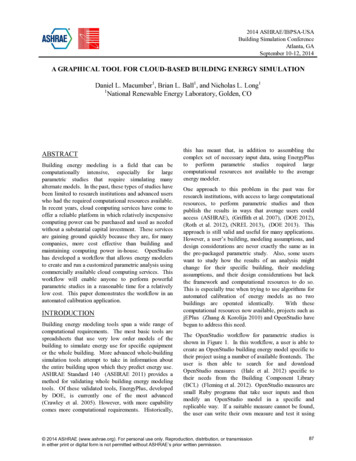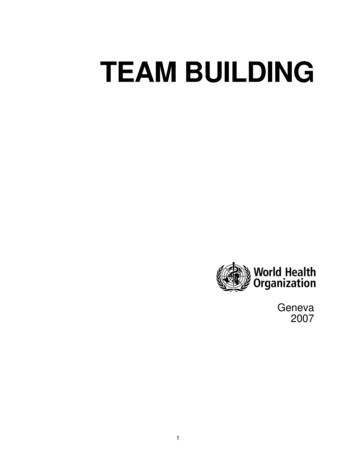
Transcription
TEAM BUILDINGGeneva20071
IntroductionThe Team building tool is part of a series of tools and has been developed to support the Cancer les/en/index.html). Team building is crucial to the development ofeffective cancer plans and programmes, and so is a multidisciplinary clinical team for the management ofpatient dignosis, treatment and palliative care.The tool is generic and can, therefore, be adapted to cancer as well as to other conditions andprogrammes where the team plays a core function.AcknowledgementsThis tool was prepared by Dr Inés Salas, University of Santiago, Chile, and was reviewed by Dr NeetaKumar, WHO consultant, Dr Cecilia Sepúlveda and Ms Maria Villanueva, WHO/HQ.This publication does not necessarily represent the decisions or the stated policy of the World HealthOrganization.2
CONTENTSSuccessful Team Building1. What is a team?42. When to use teams43. How can you select the right team for a project?53.13.23.33.4Team sizeOverall team compositionTeam member selection and exclusion criteriaMember recruitment process4. What are the usual phases of a team's PerformingDissolving or reorienting5. How to begin team building?86. Responsibilities of team leader87. Norms of a team98. Team charter: A useful document for team building109. How to sustain team effectiveness?1010. Why teams fail?1110.110.210.3External barriers to teamworkInternal barriers to teamworkGroupthink11. References1212. Resources about teaming133
1. What is a team?Team: Two or more people working interdependently towards a common goal. Getting a group of peopletogether does not make a “team.” A team develops products that are the result of the team's collectiveeffort and involves synergy. Synergy is the property where the whole is greater than the sum of its parts.Team Building: The process of gathering the right people and getting them to work together for thebenefit of a project. [Source WST] http://maxwideman.com/pmglossary/PMG T00.htmTeam Management: The direction to a group of individuals who work as a unit. Effective teams areresult-oriented and are committed to project objectives, goals and strategies.[Source PMDT]http://maxwideman.com/pmglossary/PMG T01.htmRole: A unit of defined responsibilities that may be assumed by one or more individuals.[Source SA-CMM] http://maxwideman.com/pmglossary/PMG R06.htmNorms: Acceptable standards of behaviours within a group that are shared by group members. They tellmembers what they should and should not do depending on the circumstances. In the work environmentthe most important norms deal with a performance-related process.2. When to use teams?There are several types of teams. The choice of type depends on the task to be performed, theorganizational context and the resources available. Carefully consider if some routine tasks will need tobe performed on an ongoing basis. A permanent core structure team at steering committee level may beconsidered. Its function will be to provide quality control regularly and the continuity needed to underpinsuch a large and ongoing programme (e.g. cancer control), and ensure the timely completion of projectswithin a set budget. Some examples are provided below:Table 1. Team typologies examplesDimensionExamples of team typologiesGoals and taskProblem-solving / developmental /etc.MembersSingle disciplinary team/ multidisciplinary teamFunctional / cross-functional team:Intra-organizational team/ Inter-organizationalTeamSizeSmall (say 3-4 members) / middle/large(say 8 or more members)LeadershipManager led/ team leader/ self-directedwork team4
InteractionPhysical presence / virtual (online) / mix of the twoTime or work cycleTemporary / permanentDecision- makingtechniquesInteracting groups, brain storming, nominal group, electronic meeting3. How can you select the right team for a project?Having the right core team can make or break a project. Therefore, great care should be taken whenselecting team members. It might be very useful to consider the following elements:3.1 Team size3.2 Overall team composition3.3 Team member selection and exclusion criteria3.4 Member recruitment process3.1 Team sizeRecommended size is a team of 3-12 members. A team of 5-7 members is the best.Small teams (3 or 4 members) work faster and tend toproduce results quickly, but there is less diversity.Teams greater than 7 or 8 members require an expertfacilitator and the creation of sub teams to operate effectively. They have the potential forgenerating more ideas and be more diverse.3.2 Overall team compositionEnsure that the team represents the stakeholders involved in the project. A well-rounded team includes amix of members from relevant units/organizations involved in the project having a wide range ofexperience and skills. Consider members who:belong to relevant partners organizations or organizational units of the projecthave different abilities such as:- technical expertise and skills,- administrative skills (e.g. problem-solving and decision-making skills),- interpersonal and communication skills.The team could include:People who understand the project very well such as, for example, those already working incancer control (e.g. public health specialists, cancer institutes programme managers, cancersocieties, professional associations, and cancer patient groups),People who are technical experts (e.g. health care providers from oncology services),People who can provide objectivity in the process and outcome (e.g. NGOs, communityleaders, cancer patient self-help groups, non-health professionals),Suppliers (e.g. pharmaceutical department at the ministry, funding agencies).5
3.3 Team member selection and exclusion criteriaYou need the "best and brightest" on your team, but even those people must work well together for theproject to succeed. When selecting team members, give preference to individuals who are:Concerned about and committed to the common purpose and goals (interested in the project)EnthusiasticOptimisticCreative, flexible and open mindedProactiveGood team players:-Work effectively as a member of a teamRespect the values, beliefs and opinions of othersRelate to and interact effectively with individuals and groupsAre willing to cooperate to reach common goalsWell respected among peers and other leadersCan devote time to the initiative.It is also useful to develop your own "exclusion criteria" about team members. In cancer controlplanning, for example, those associated with tobacco production or promotion, or who may havebusiness interests in the project should not be included. Members should not be selected merelybecause of their high position within the system. They can be very as advisers or facilitators in a team,but may bot be bale to devote time for field work, such as data collection in a needs assessment team.Professionals from various disciplines should be chosen e.g. nursing, general medicine, specialities likegynaecology and oncology, surgery, public health, sociology, economics or management.3.4 How to recruit the best members for your team?Keep in mind the project goals and the selection criteria mentioned above.Identify relevant people in partner organization/s or unit/s. Make informal contact with thosewho have been identified, as well as with anyone who knows them to see if they fulfill thecriteria. Include their interest in the project and the time needed to integrate the project.Decide if he/she is the right person with the preliminary information you have.Invite the person to join the team.After this exercise complete Table 2 below.Table 2. Characteristics of possible team membersOrganizationPossible teammemberPosition6Potential area(s) of contribution to theSkills and technical knowledge orresources
4. What are the usual phases of a team's development?A team is a living and dynamic entity. It could progress from an early to a mature phase, independent ofthe nature of the team or the task it must perform. Tuckman's model (2) proposed the following typicalphases in team development:4.1 Forming: This is the initial orientation period. The team is unsure about what it is supposed to do,members do not know each other well or are not yet familiar with the way the team leader and the othermembers function. This stage is complete when the members begin to see themselves as a part of thegroup.4.2 Storming: This is a sorting out period where members begin to find their place as team members.The team members now feel more comfortable giving their opinion and challenging the team leader'sauthority and recommendations. Some members may become dissatisfied and challenge not only thetasks of the team and how these will be carried out, but also the leader's role and style of leadership.This is the start of intragroup conflicts.4.3 Norming: Team members begin to use their past experiences to solve their problems and pulltogether as a cohesive group. This process should result in the team establishing procedures forhandling conflicts, decisions, and methods to accomplish the team projects.4.4 Performing: In this phase the team has achieved harmony, defined its tasks, worked out itsrelationships, and has started producing results. Leadership is provided by the team members bestsuited for the task at hand. Members have learned how to work together, manage conflict and contributetheir resources to meet the team's purposes.4.5 Dissolving or reorientating: The team dissolves when the team has completed the project. It maybe reoriented to continue on a next phase of the project.7
5. How to begin team building?There are three main components in any team's work :1. Goal: Result-oriented tasks or content aspect (e.g. team goals and objectives). These areusually developed through interaction with team members;2. Methodology: Process aspect, which includes the team's interactions and how memberswork together (e.g. leadership, team roles, etc.) Teams, especially technical teams,frequently struggle more with process issues than with task issues;3. Resources: Time, budget, computer facility, educational tools and administrative support.Useful questions for team buildingWho are the team members, team leaders and team liaison members?What is the reason this team exists? What is the common vision, what are the goals andtargets?What are the norms that will guide how the team will work together?What results are expected for this team? What are the outputs expected from the team andby when? To whom should they be given?What is their agreed-upon strategy?What are the steps to be followed by this team?What are the team roles and who will play them?Who is the responsible for these roles?What are the norms and methodologies about:- decision- making- problem-solving process- conflict resolution- communication, cooperation and responsibility- task management- meetings- rewardsWhat are the resources available to support the teamwork?Who will support the team if needed?6. Responsibilities of team leaderAssign clear tasks to each memberRegularly review and monitor progress of workEnsure that the team meets deadlinesDiscuss and agree on the timetable for major activities with the teamMotivate team membersResolve conflictsGive guidance when neededHelps members to overcome barriersRegularly assess team performance using a checklist8
7. Norms of a teamNorms are acceptable standards of behaviors within a group that are shared by group’s members. Theytell members what they should or should not do depending on the circumstances. In the workenvironment the most important norms deal with performance-related process.All members should become familiar with these norms and are expected to follow them. It is a good ideato agree on the norms and include them in the team charter.Examples of written normsTeam leadership: The leader/mediator/facilitator has control over the process, e.g. controlswhen and how much people speak.Communication and interpersonal relationships among team members.ListenAllow one person to speak at a time, and avoid side conversations.Don't interrupt when a person is talking unless he/she is diverting from the issue beingdiscussed.Before evaluating a member's contribution, others check their assumptions to ensure thatthey have properly understood.Seek first to understand others before you seek to be understood.Respect the views of all participants.TalkMeetingsEveryone participates.Each person speaks on his/her own behalf and lets others speak for themselves.Each persn takesresponsibility for his/her actions and results.One always has three options: accept it, work on it to make it better, or leave. Don'tcomplain if you're not willing to make it better.Speak openly and honestly.Say what you mean and mean what you say, but preserve people's self-esteem.Members can disagree without fear.Give negative feedback appropriately: calmly, timely, privately, using present information,focused on issues and behaviours (not individuals). Disagree with what was said, but notwith who said it.Give specifc positive feedback (recognition) right away in public, but adapted to the receiver.Call a time out if you need one.Communicate immediately if you think you may not be able to fulfill an agreement.If you don’t understand something, ask for clarification.If you see a problem that others haven’t noticed, bring it to someone’s attention.Clear communication of accountabilities for all work team members.Clear objectives.Meetings must have an agenda.Meeting information needs to be circulated to everyone prior to the meeting.Use the meeting time and keep the discussion focused on the meetings objective(s).Start and end meetings on time.Use technological tools such as television or video- conferencing to facilitate the meeting.Time management : meeting task deadlines9
8. Team charter: A useful document for team buildingA team charter is a written do
Team building is crucial to the development of effective cancer plans and programmes, and so is a multidisciplinary clinical team for the management of patient dignosis, treatment and palliative care.
